
César Manrique, the visionary artist, architect and environmentalist whose influence is seen all over Lanzarote, spent his childhood holidays in Famara and always said it was his favourite place. Born in Arrecife, the capital of Lanzarote, in 1919, he went on to study quantity surveying in Tenerife at La Laguna University, He was a volunteer in the Spanish Civil War (1936 – 1939) on Franco’s side which was evidently hugely traumatic experience for him, he returned at the end of the war in 1939 refusing to speak about the experience and allegedly burned his uniform on the roof of his house on his return to Lanzarote.
Following his two years in University he went on to Madrid in 1945 to the San Fernando School of Fine Art, spending five years there and graduating with a teaching diploma in drawing and painting. He met Pepi Gomez whilst in Madrid who was to be his partner for 18 years. He lived in Madrid and New York before returning to the island in 1966.
 Passionate about his homeland, he campaigned for the introduction of regulations that saved Lanzarote from the ravages of rampant development. a major influence on the planning regulations in Lanzarote, he recognised Lanzarote’s tourist potential and lobbied successfully to encourage sympathetic development of tourism, not to build above two stories hence the lack of high-rise buildings on the island, no advertising boards, the houses must be painted white with blue or green window frames and doors keeping a traditional look.
Passionate about his homeland, he campaigned for the introduction of regulations that saved Lanzarote from the ravages of rampant development. a major influence on the planning regulations in Lanzarote, he recognised Lanzarote’s tourist potential and lobbied successfully to encourage sympathetic development of tourism, not to build above two stories hence the lack of high-rise buildings on the island, no advertising boards, the houses must be painted white with blue or green window frames and doors keeping a traditional look.
He also designed a series of extraordinary buildings which accentuate the unique geology of Lanzarote as well as making funky wind sculptures to adorn roundabouts across the island.



"Lanzarote is like an unframed, unmounted work of art," he famously said, insisting that anything manmade should be integrated into the landscape.
Manrique died in a car accident near the Fundación in 1992 aged 73. A young local was driving too fast and unable to control the car caused the tragic accident. In memory of his tireless work for the island locals erected a memorial to him on the exact spot where he died.

MIRADOR DEL RIO 1971

An old military observation post, guards watched for clandestine activity. Manrique persuaded the Spanish government to turn it into a tourist attraction. It is on an approximately 475-metre-high cliff called Batería del Río in the north of the island.
The location was created in between 1971 and 1973 in his typical style, consisting of a balustraded café, a souvenir shop and a platform on its top which are integrated into the lava rock. The technical realization of the work was carried out by Eduardo Cáceres and Jesús Soto and it was in 1973 when El Mirador del Río was inaugurated. Its surroundings have been declared a protected natural area. The building has the peculiarity that is barely visible from the outside thanks to a subtle and ingenious camouflage manoeuvre of hiding its structure under a heavy stone skin that blends in with the environment.






After entering the building through a winding corridor, there are two spacious vaulted rooms with large glass windows—the eyes of the Mirador—that have an extraordinary panoramic view over the Strait of El Rio, the narrow channel which separates Lanzarote from La Graciosa island. On clear days, beyond the view of La Graciosa, the small islands of Montaña Clara and Roque del Oeste can be seen, with the furthest of them all being Alegranza, these are part of the Chinijo Archipelago.

JAMEOS DEL AGUA 1966

Part of a 6Km long lava tube which formed about 3,000 years ago when the Montana La Corona erupted. Molten lava continued to flow as the surface hardened, which in turn led to the formation of the tubes, which run down under the Atlantic. The word Jameo is used in reference to the large openings in the tube which formed when parts of the roof collapsed due to a pressure build up caused by the volcanic gases.


It is these open-air caves which Manrique exploited as the centrepiece for the attraction, It has since become a National Park and now contains a restaurant and a concert hall where the acoustics are said to be pitch perfect, also a night club, of which which Manrique said “The best Night club in the world”


To get to the night club and restaurant you have to go through an underwater cavern and past a large cave pool.This natural lake has extremely clear water — regulated by the Atlantic Ocean, it is home to a species of blind albino crabs known as ‘Jameitos’ which are only found on Lanzarote. These crabs have been adopted as the symbol of the Jameos del Agua, it is the only known type of blind white crab of its kind in the world. The tube stretches approximately 1.5 km under the sea.
In a space completely open to the sky is a delicious pool sculpted out of the rock and plastered dazzling white, there's a staircase to the upper level with extensive views of the coast.

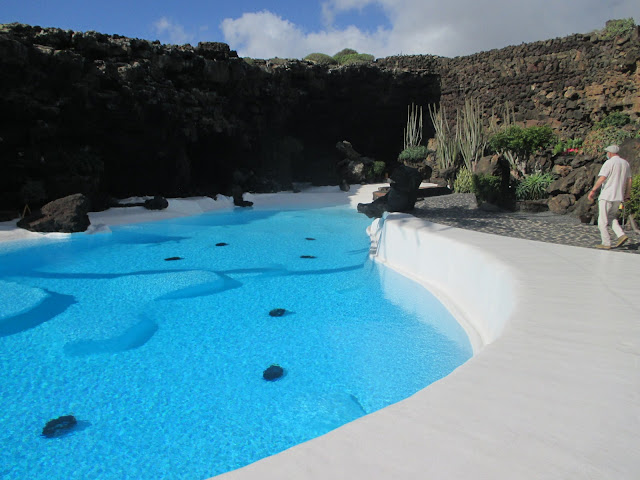

TARO DE TAHICHE 1968

César Manrique’s genius can be seen all over Lanzarote, but a full idea of the immense vision and enchanting character of the man himself is most evident at his first major creation, Taro de Tahiche, the astonishing home he built in the air bubbles and tunnels trapped in a volcanic lava flow.
In 1963, César Manrique’s beloved partner, Pepi Gómez, died of cancer in Madrid, the artist was devastated. Friends advised a change of scene, he went to New York, where he spent two years enjoying the city’s exciting cultural and social scene. Apparently, this is where he “embraced” experiments into gay life which had been suppressed in the stifling atmosphere of fascism under Franco’s rule, just remember what happened to Federico Garcia Llorca, murdered by the fascists in 1936 when Manrique was 17, a formative age and an event he would remember. It was a time when the repression of homosexuals was brutal. Homosexuality was highly illegal under several different laws which were vigorously enforced. The condemned were sent to special prisons called "galerías de invertidos", halls for the inverted. This was a common practice until 1975, when Franco's regime gave way to the current constitutional democracy. Finally in the cultural movement known as La movida in Madrid and the repeal of the laws against homosexuality allowed a more liberal atmosphere where many gay artists and musicians could flourish without fear, for example Pedro Almadover who knew Manrique and made one of his films on location in Lanzarote, he said
"Broken Embraces is a total homage to Manrique. I met him on that first trip back in the 80s, and he took me all over the island and showed me his Lanzarote."
Manrique was 47 when he returned to Lanzarote in 1966. Two years later, he’d built the home that he would live in for the next 20 years – a creation so astonishing, so unique, that it attracted the attention of the world.


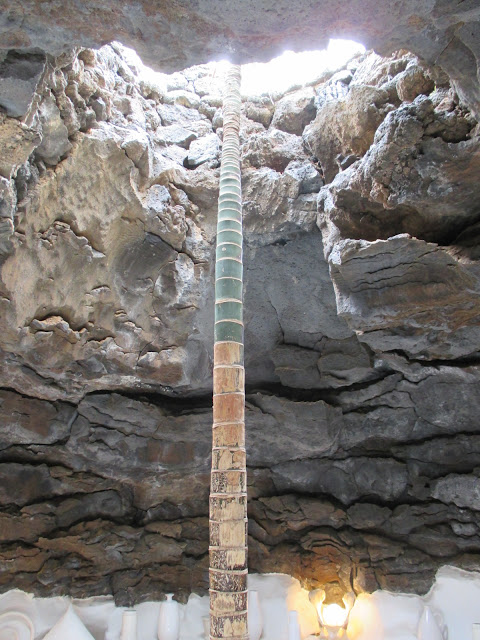

In 1963, César Manrique’s beloved partner, Pepi Gómez, died of cancer in Madrid, the artist was devastated. Friends advised a change of scene, he went to New York, where he spent two years enjoying the city’s exciting cultural and social scene. Apparently, this is where he “embraced” experiments into gay life which had been suppressed in the stifling atmosphere of fascism under Franco’s rule, just remember what happened to Federico Garcia Llorca, murdered by the fascists in 1936 when Manrique was 17, a formative age and an event he would remember. It was a time when the repression of homosexuals was brutal. Homosexuality was highly illegal under several different laws which were vigorously enforced. The condemned were sent to special prisons called "galerías de invertidos", halls for the inverted. This was a common practice until 1975, when Franco's regime gave way to the current constitutional democracy. Finally in the cultural movement known as La movida in Madrid and the repeal of the laws against homosexuality allowed a more liberal atmosphere where many gay artists and musicians could flourish without fear, for example Pedro Almadover who knew Manrique and made one of his films on location in Lanzarote, he said
"Broken Embraces is a total homage to Manrique. I met him on that first trip back in the 80s, and he took me all over the island and showed me his Lanzarote."
Manrique was 47 when he returned to Lanzarote in 1966. Two years later, he’d built the home that he would live in for the next 20 years – a creation so astonishing, so unique, that it attracted the attention of the world.




Taro de Tahiche, is built into the boulders and the air bubbles created during a lava flow. The project started when Manrique discovered a cave in the huge lava flow that spills down from Timanfaya, passing Tahiche to touch the sea near Arrecife. He climbed down to rest under one of the fig trees that farmers often planted in these hollows and was amazed to discover a series of volcanic bubbles and a tunnel. This, he decided, would become his home and so it did.
Now a foundation dedicated to his life and work, its ground floor is an exhibition space with works by his renowned contemporaries, including Tàpies, Millares, Picasso and Saura, but it is the view framed by the huge windows that draws the eye.






Basalt steps lead down to a turquoise pool and five lava bubbles linked by passages in the volcanic rock. It looks more like a groovy nightclub than a home. "Oh yes, I went to some pretty wild parties there," remembered Almodóvar, laughing.
Manrique’s now openly gay life added to his scandalous image in Franco’s Spain. It was little known that Manrique was a health fanatic, a non-smoker and non-drinker who never stopped working, and despite his many friends, his most constant companions were his dogs.
The original cave is now the centrepiece of the main room in which you first enter the building, in a space surrounded by artworks, photos and mementoes of the artist’s life. A spiral staircase that leads to the underground level is now out of use, but visitors can instead enjoy the spectacular view of the pool and garden below as they descend outdoors.

Now a foundation dedicated to his life and work, its ground floor is an exhibition space with works by his renowned contemporaries, including Tàpies, Millares, Picasso and Saura, but it is the view framed by the huge windows that draws the eye.






Basalt steps lead down to a turquoise pool and five lava bubbles linked by passages in the volcanic rock. It looks more like a groovy nightclub than a home. "Oh yes, I went to some pretty wild parties there," remembered Almodóvar, laughing.
Manrique’s now openly gay life added to his scandalous image in Franco’s Spain. It was little known that Manrique was a health fanatic, a non-smoker and non-drinker who never stopped working, and despite his many friends, his most constant companions were his dogs.
The original cave is now the centrepiece of the main room in which you first enter the building, in a space surrounded by artworks, photos and mementoes of the artist’s life. A spiral staircase that leads to the underground level is now out of use, but visitors can instead enjoy the spectacular view of the pool and garden below as they descend outdoors.

The first stop is the White Bubble, which celebrates Manrique’s love of parties with several photos of the artist relaxing, laughing and holding court in his amazing headquarters. It’s clear that the man had a huge appetite for life, and several articles from magazines of the time make the most of the space-age setting and the relaxed atmosphere where nudity and hedonism seemed to be everywhere.

A small tunnel leads to the Red Bubble – the cave which first inspired Manrique, where the original fig tree, now long dead, still stands. The swimming pool area is where Manrique first developed the artistic ideas that he realised on a much larger scale at the Jameos del Agua. The delicious turquoise pool is highlighted with brilliant white, surrounded by black lava walls and tumbling greenery. There’s even a small dancefloor.
Passing through the Black and Yellow Bubbles, you eventually go back upstairs reaching the room where Manrique built a window over a tongue of lava, which enters the room beneath a beautiful view of the volcanic landscape beyond, where solitary palms nod in the breeze.



A small tunnel leads to the Red Bubble – the cave which first inspired Manrique, where the original fig tree, now long dead, still stands. The swimming pool area is where Manrique first developed the artistic ideas that he realised on a much larger scale at the Jameos del Agua. The delicious turquoise pool is highlighted with brilliant white, surrounded by black lava walls and tumbling greenery. There’s even a small dancefloor.
Passing through the Black and Yellow Bubbles, you eventually go back upstairs reaching the room where Manrique built a window over a tongue of lava, which enters the room beneath a beautiful view of the volcanic landscape beyond, where solitary palms nod in the breeze.


There are films showing the life of Manrique. In some, he’s the perfect, playful host, in others, a passionately serious campaigner against the destruction of Lanzarote by speculators. Manrique believed that “without ethics there are no aesthetics”, and he lived by that motto.

An interesting discovery is that Manrique was a passionate Soul music fan. A selection of original albums by James Brown, Sam & Dave and Edwin Starr that he brought back from New York are on display, and an entry in his diary for the June 20th, 1966 he writes “In the afternoon we went to get tickets for Sam & Dave at the Apollo (Harlem’s legendary Apollo Theatre). The show, as always, was amazing. "After hearing black jazz bands and singers you can’t listen to anything else. The power and rhythm penetrate to the very deepest parts.”
In 1988, Manrique moved to a rambling, traditional home in Haría, converting Taro into a tourist attraction and the HQ of the César Manrique Foundation, which continues to fight for his beliefs and vision. It is perhaps Manrique’s most important legacy on the island he transformed.
LagOmar


Probably the most sophisticated and the least known place conceived by the master in Lanzarote is LagOmar, an oasis of Arabic inspiration built on a volcanic quarry taking advantage of labyrinths and natural caves, named after the Egyptian actor Omar Sharif. This is an example of a dynamic space, that has kept evolving and growing since Manrique first designed it, always respecting the original artistic style.
In the 1970s, Omar Sharif came to Lanzarote to shoot the film The Mysterious Island based on the book L’Île Mystérieuse by Jules Verne. There are different stories that connect Sharif with this place but the most popular tells that once he discovered the site he immediately fell in love with it and bought it. However, only two days after the actor had acquired this wonderful site, Sam Benady, the agent who sold it to him, wanted to recover it desperately.
Knowing Omar’s love for gambling, Benady challenged him to a game of Bridge hiding the fact that he was the European champion. As was expected, the agent ended up recovering his old property. It’s been said that this story was made up by Benady as a promotion strategy, using Omar Sharif’s fame to sell real estate in Nazareth. At this time LagOmar was in a very embryonic state, loads of potential for creativity but the finished work was just a dream until 1989 when Argentine architects Beatriz van Hoff y Dominik von Boettinger began the transformation with the magic touch of Manrique and architect Jésus Soto.
In the 90’s LagOmar was transformed into a spectacular club with multiple areas that offered different ambiances and music styles to the visitor, electronic, house and chill out, perfect for this with the many chambers and caves which form the site. A magical terrace stands between the restaurant and the club, like a true oasis filled with lush vegetation that reflects on the glimmering pool. A delight for the senses, and the best vantage point to admire a stunning unique environment. All these spaces still exist, although no longer a club it is open to the public. One is free to wander around the whole of LagOmar, I think it would take a few visits to remember the stunning complexity of the plan, it is truly labyrinthine with caves, stepping stones through water tunnels, balconies, numerous patios and gardens, the lush greenery of flowering shrubs and palms add to the feeling of a delightful fantasy world, quite an adventure.























Manfred was having a drink at the café, he kept glimpsing me as I appeared and disappeared somewhere on the precipitous red cliff. Right at the top there is a glass cupola with a secluded room made containing a card table, on the wall is a blown up photo of Omar Shariff playing bridge, maybe the fateful game where LagOmar took a new direction.

CASA-MUSEO CÉSAR MANRIQUE HARIA 1988

 The César Manrique House Museum is located in a beautiful palm grove in the picturesque old village of Haria, which still conserves many of Lanzarote’s traditions. In Haría the artist found the peace and harmony with nature that was so important for his creativity.
The César Manrique House Museum is located in a beautiful palm grove in the picturesque old village of Haria, which still conserves many of Lanzarote’s traditions. In Haría the artist found the peace and harmony with nature that was so important for his creativity.
In early 1986, he began to build his new home, renovating and adapting a ruined farmhouse on farmland he had purchased in the 1970s. Manrique revisited the language of traditional architecture with a modern vision governed by aesthetics and comfort. He lived here until his death in 1992. In 2013 the house was opened to the public as a home and museum. Visitors can see the rooms and grounds where he lived and worked during the last years of his life.
Two courtyards introduce the visitor to a surprising world of personal belongings, utensils, objects found by chance and handcrafted accessories that Manrique turned to an aesthetic purpose. This house feels like a comfortable home not a wild fantasy as the former creations no matter how visually exciting they might be

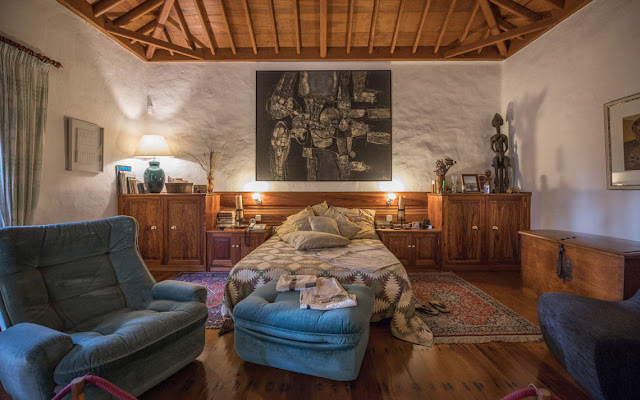






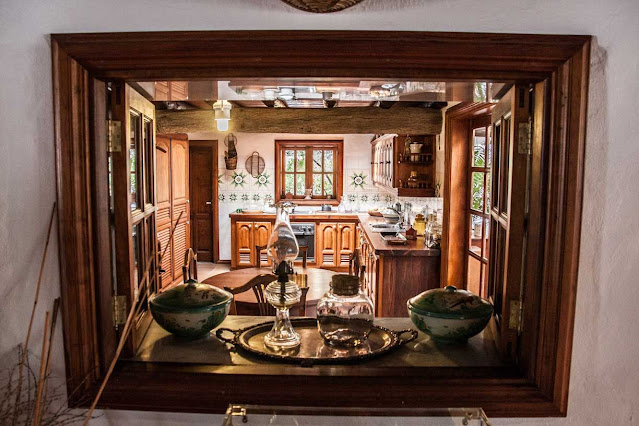
The exuberant plant life of the garden adds to a great atmosphere and continues inside the house with plants everywhere.



The studio is in a separate building in the garden where the artist painted daily, surrounded by multi media materials, tables laden with drawings, easels and unfinished paintings.






It has been conserved just as he left it when he died. We very much enjoyed walking through this house and going on to discover the village with many old, charming houses set among the extensive palms and flowering shrubs.


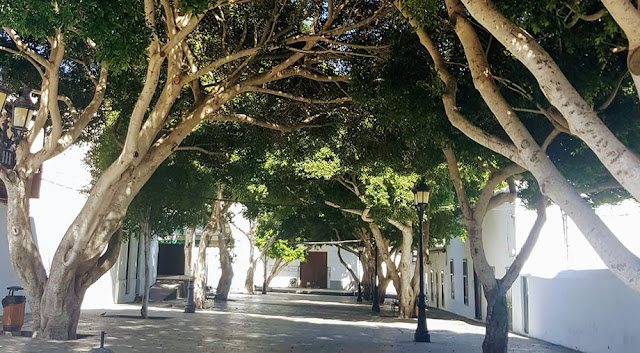
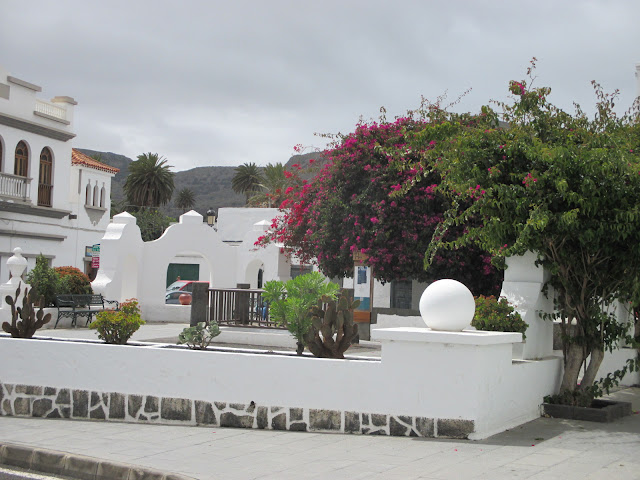



There is a very lively market on Saturdays with some interesting stalls, a man selling his hand rolled cigars made from Canary tobacco, a woman selling silk scarves dyed in gorgeous shades from the cochineal beetles which were introduced into Lanzarote from Mexico in the early 19th century and thrive on the Opuntia cactus growing everywhere, lots of handmade jewellery made from lava rock and coral , pottery including the quaint naked figures that men and women traditionally used as a means of declaring themselves to a potential suitor. As well as local cheeses, artisanal bread and cakes, super fresh vegetables and piles of chubby canary bananas. Some cool bars and cafés with tables beneath the enormous shady trees. I can definitely see what attracted Manrique to Haria.






.JPG)


An interesting discovery is that Manrique was a passionate Soul music fan. A selection of original albums by James Brown, Sam & Dave and Edwin Starr that he brought back from New York are on display, and an entry in his diary for the June 20th, 1966 he writes “In the afternoon we went to get tickets for Sam & Dave at the Apollo (Harlem’s legendary Apollo Theatre). The show, as always, was amazing. "After hearing black jazz bands and singers you can’t listen to anything else. The power and rhythm penetrate to the very deepest parts.”
In 1988, Manrique moved to a rambling, traditional home in Haría, converting Taro into a tourist attraction and the HQ of the César Manrique Foundation, which continues to fight for his beliefs and vision. It is perhaps Manrique’s most important legacy on the island he transformed.
LagOmar


Probably the most sophisticated and the least known place conceived by the master in Lanzarote is LagOmar, an oasis of Arabic inspiration built on a volcanic quarry taking advantage of labyrinths and natural caves, named after the Egyptian actor Omar Sharif. This is an example of a dynamic space, that has kept evolving and growing since Manrique first designed it, always respecting the original artistic style.
In the 1970s, Omar Sharif came to Lanzarote to shoot the film The Mysterious Island based on the book L’Île Mystérieuse by Jules Verne. There are different stories that connect Sharif with this place but the most popular tells that once he discovered the site he immediately fell in love with it and bought it. However, only two days after the actor had acquired this wonderful site, Sam Benady, the agent who sold it to him, wanted to recover it desperately.
Knowing Omar’s love for gambling, Benady challenged him to a game of Bridge hiding the fact that he was the European champion. As was expected, the agent ended up recovering his old property. It’s been said that this story was made up by Benady as a promotion strategy, using Omar Sharif’s fame to sell real estate in Nazareth. At this time LagOmar was in a very embryonic state, loads of potential for creativity but the finished work was just a dream until 1989 when Argentine architects Beatriz van Hoff y Dominik von Boettinger began the transformation with the magic touch of Manrique and architect Jésus Soto.
In the 90’s LagOmar was transformed into a spectacular club with multiple areas that offered different ambiances and music styles to the visitor, electronic, house and chill out, perfect for this with the many chambers and caves which form the site. A magical terrace stands between the restaurant and the club, like a true oasis filled with lush vegetation that reflects on the glimmering pool. A delight for the senses, and the best vantage point to admire a stunning unique environment. All these spaces still exist, although no longer a club it is open to the public. One is free to wander around the whole of LagOmar, I think it would take a few visits to remember the stunning complexity of the plan, it is truly labyrinthine with caves, stepping stones through water tunnels, balconies, numerous patios and gardens, the lush greenery of flowering shrubs and palms add to the feeling of a delightful fantasy world, quite an adventure.























Manfred was having a drink at the café, he kept glimpsing me as I appeared and disappeared somewhere on the precipitous red cliff. Right at the top there is a glass cupola with a secluded room made containing a card table, on the wall is a blown up photo of Omar Shariff playing bridge, maybe the fateful game where LagOmar took a new direction.

CASA-MUSEO CÉSAR MANRIQUE HARIA 1988

 The César Manrique House Museum is located in a beautiful palm grove in the picturesque old village of Haria, which still conserves many of Lanzarote’s traditions. In Haría the artist found the peace and harmony with nature that was so important for his creativity.
The César Manrique House Museum is located in a beautiful palm grove in the picturesque old village of Haria, which still conserves many of Lanzarote’s traditions. In Haría the artist found the peace and harmony with nature that was so important for his creativity.In early 1986, he began to build his new home, renovating and adapting a ruined farmhouse on farmland he had purchased in the 1970s. Manrique revisited the language of traditional architecture with a modern vision governed by aesthetics and comfort. He lived here until his death in 1992. In 2013 the house was opened to the public as a home and museum. Visitors can see the rooms and grounds where he lived and worked during the last years of his life.
Two courtyards introduce the visitor to a surprising world of personal belongings, utensils, objects found by chance and handcrafted accessories that Manrique turned to an aesthetic purpose. This house feels like a comfortable home not a wild fantasy as the former creations no matter how visually exciting they might be









The exuberant plant life of the garden adds to a great atmosphere and continues inside the house with plants everywhere.



The studio is in a separate building in the garden where the artist painted daily, surrounded by multi media materials, tables laden with drawings, easels and unfinished paintings.






It has been conserved just as he left it when he died. We very much enjoyed walking through this house and going on to discover the village with many old, charming houses set among the extensive palms and flowering shrubs.







There is a very lively market on Saturdays with some interesting stalls, a man selling his hand rolled cigars made from Canary tobacco, a woman selling silk scarves dyed in gorgeous shades from the cochineal beetles which were introduced into Lanzarote from Mexico in the early 19th century and thrive on the Opuntia cactus growing everywhere, lots of handmade jewellery made from lava rock and coral , pottery including the quaint naked figures that men and women traditionally used as a means of declaring themselves to a potential suitor. As well as local cheeses, artisanal bread and cakes, super fresh vegetables and piles of chubby canary bananas. Some cool bars and cafés with tables beneath the enormous shady trees. I can definitely see what attracted Manrique to Haria.






.JPG)

No comments:
Post a Comment
Follow the latest news from Finca al-manzil- What to do and see in Extremadura and Beyond.............